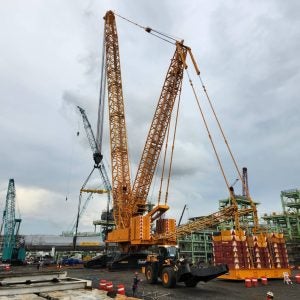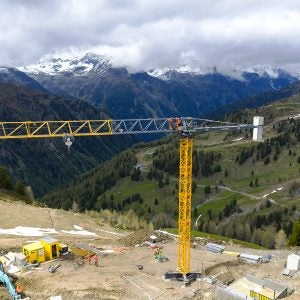
With the Rising Factory, Mace aims to further develop lean construction technology, with a technique that allows for faster working, with less risk from working at height, and reduced impact on the community around the job site.
The project consists of two 30-storey towers, and a ten-storey complex, being built by Mace for developer Qatari Diar. The two systems used to build the towers were developed by Mace, working with Turkish steel fabricator Metal Yapi (who also, through a sister company, supplied the cladding of the building) and with engineering support from Dorman Long Technology. Lifting on the ten-storey building is being performed using a Wolff luffer. James Rushton, Mace’s project engineer for the Rising Factory, showed Cranes Today around the site.
The system’s steel components were shipped from Turkey to Purfleet in the UK. The original plan, Rushton explains, had been for the modules to be shipped part-assembled. However, with limited shipping between the ports, it was only economically feasible to ship the pieces fully disassembled. This lead to one of the first big challenges of the project, as Rushton’s team had to sort through more than 20,000 steel pieces and drums of bolts, as if preparing an Ikea wardrobe of nightmare proportion.
The system encloses the working floors of the building, with a tandem 15t + 15t double girder gantry crane from Gülenc used to bring materials from the ground, and a second 15t crane used for placing materials as the initial concrete work is performed on the top floor.
The factory is raised using four 250t capacity Dorman Long DL-CP250 pinned climbing jacks controlled by a DL-P40 computer control system. On the first jump in February, the 565t partially assembled factory was raised roughly 6.6m (two stories), twice the standard distance, to allow for assembly and cladding of the factory. Once the factory was fully assembled, it weighed 860t, or roughly the same as the occupancy loading of the building. This means that it can be used and raised without any need for changes to buildings design or strengthening of mounting points. During construction, the weight of the Rising Factory is supported by four hydraulically-operated pins that connect it to the building via jump brackets on each corner column. All vertical and horizontal loads from the Rising Factory are transferred to the building via these Main Pins. During factory operation the pinned climbing jacks and climbing bars are not subjected to any imposed loads. When the Rising Factory is jumped, the main pins are hydraulically withdrawn and the pinned climbing jacks lift the climbing bars fitted to the Rising Factory.
With the working floors covered, and platforms built into the structure for material delivery, Mace aims to finish a storey a week. Floor sections for the concrete pour and columns are brought up to the top floor. On the floors below, modules are lifted onto a cantilever platform and moved into place to supply all of the services that will be used in the finished building.
With lean construction techniques at the heart of the project, tools and materials for each of the trades working on the building are packaged together and delivered to the working floor each week.
Once the concrete has been poured, modules and pods positioned, and interiors fitted out, the cladding sections and aesthetic facades are lifted onto the launch deck, and fitted using four 1t monorail hoists.
The project aims to use just-intime techniques to reduce space needed for materials on site. This requires a delivery every 13 minutes during working hours.
A similar technique was used on a project in Rotterdam, the Netherlands. However, there, the project was developed for the technique. With its £9m investment in developing the system and buying all of the components, Mace aims to be able to re-use the system, on structures that have not been built with it in mind.
Rushton explained that the system can be modified for differently sized and shaped buildings, even including circular ones. When Cranes Today visited the site, Mace was in negotiations for contracts on five other towers. The contractor is also working with Australian pre-fab modular construction specialist Hickory to develop the system for direct delivery of volumetric modules, further speeding up construction.
When construction is complete, within 30 weeks of the project start if all goes to plan, the Rising Factory will need to be disassembled. This will follow a similar method to that used on tower cranes. First, the system will disassemble many of its own components, making use of a luffing jib crane fitted to the gantry. Then, a 30t capacity derrick, built out of pieces small enough to fit into an elevator, will be used to dismantle the remaining sections of the system.







